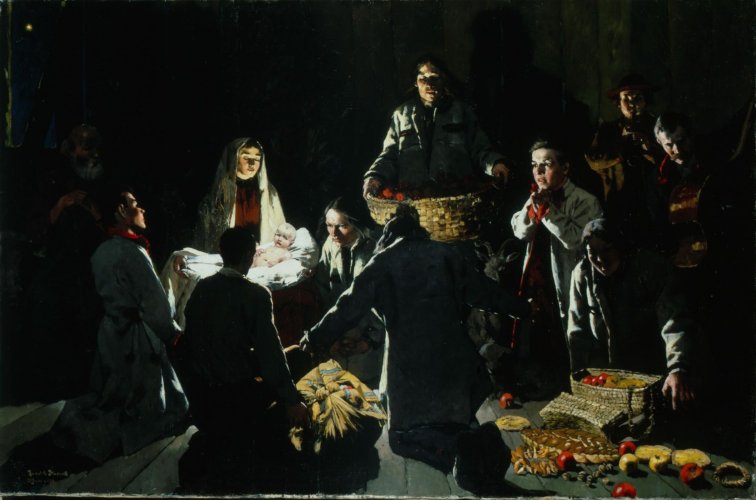Description:
Ludwik Stasiak (1858-1924) was born in a middle–class family in Bochnia near Krakow. After graduating from high school in Krakow, he began studying philosophy and painting. He abandoned the first direction after two years, focusing on creativity. In the years 1897–1880 he perfected his craft under the eyes of, among others, Jan Matejko. After completing school, he traveled and further perfected himself in Vienna and Munich. After returning to Krakow in 1902, for years he exhibited his works in the Salon of the Society of Friends of Fine Arts, of which Edward Aleksander Raczyński was the president at that time. He was friends with Włodzimierz Tetmajer, Władysław Skoczylas or Jacek Malczewski, whom he often hosted in his Bochnia studio. He was also a writer, critic and art historian*.
Description of the painting:
In the painting, a scene is depicted taking place in a darkened room. The figures portrayed in it, based on their costumes, can be identified as highlanders. They are dressed in characteristic cuchy – white outerwear and portki – highlander trousers. The gathered group is clustered around the baby held in the lap of its mother. Through the title and composition of the work, Stasiak gives this scene an additional dimension. The title – W Betleem, written in its original form, as well as the title Highlanders–shepherds bring gifts to P. Jesus from the pre–war Rogalińska Gallery catalog, leaves no doubt that the scene concerns the birth of the Baby Jesus and the homage of the shepherds. Similarly to the earlier discussed painting “Madonna with Sparrow“ by Wlastymil Hofman, the characters from the Bible are represented by the Polish people, which places the work in the stream of chłopomania. The presented highlanders bow to the newborn Christ and give him gifts. In the foreground we see the backs of two kneeling men in front of the Baby. Such positioning of the figures excludes the observer from the event, although it can also be interpreted as giving him the role of another arriving shepherd to welcome the Lord. The center of the second plan has been slightly shifted towards the left edge of the painting. It is strongly emphasized figure of the Baby Jesus. The naked boy lies on a white canvas, his gaze fixed on those who have arrived. He is held by a sitting mother, dressed in a red fastened under the neck dress. The woman‘s head is covered with a white embroidered scarf, possibly a festive highlander scarf – a rańtuch. Her face is calm, focused on her son. The significance of the child‘s figure is emphasized by its exceptional illumination. Both the body and the material on which it lies have been painted in bright, luminous colors. The glow emanating from it falls both on the woman and on the highlanders gathered around him, illuminating their faces. At the mother‘s left side is visible a young shepherd shown in profile, in a kneeling position. Behind him, emerging from the darkness, is a male figure with a long beard. It may be Joseph accompanying Mary. On the right, almost next to Jesus‘ head, a highlander is kneeling, looking at Him. His hands are folded in prayer. A little further away there are three more men, positioned diagonally, offering baskets of gifts. The boy in the middle kneels, holding folded hands to his face, on which admiration and piety are written. The right edge of the painting is closed by two male figures, dressed in dark coats, thus separating them from the group in the center, which is kept in light colors. They are playing on the bass and the bagpipe. The special character of the scene is emphasized by the festive clothes of the guests. The gifts offered to the Holy Family are visible on the wooden floor and in the baskets. The way they are presented and kept in gold and red gives the illusion of precious objects. The highlanders offer fruits, nuts, loaves of bread/buns, cakes – gifts of nature, that which is most precious can be given by a people living in harmony with nature. Among them, in the lower right corner, is the symbol of Krakow – obwarzanki, which emphasize where chłopomania has its roots. A package is also visible, in which clothes or fabric may be found.
The combination of highlander folklore and the mysticism of the biblical scene gives a new dimension to folk culture. Highlanders are elevated and gain the honor of having a direct contact with the Savior. This shows the special role of peasantry in the works of artists of this period.


